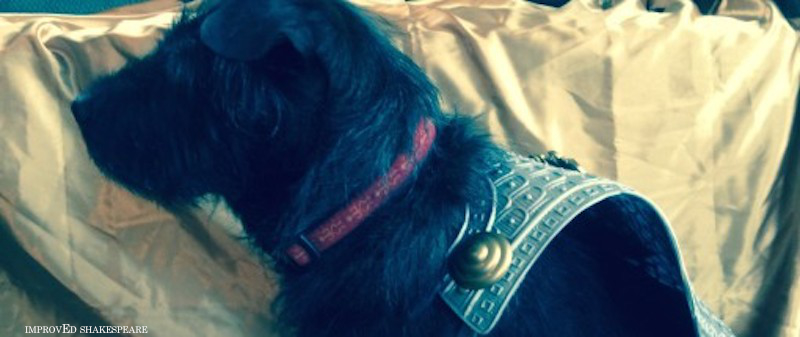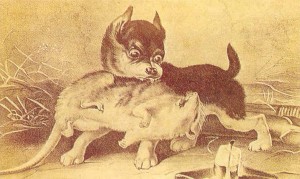Blood Sports in the Renaissance
| by Prince Ferdinand |
In the Renaissance, they were pretty cruel to animals. In fact, they had lots of sports where animals would die for the audiences’ amusement! Here are six of the sports: bear baiting, dog fighting, rat baiting, cock fighting, badger baiting, and bull baiting. A well-researched library page tells us that, “As the Middle Ages drew to a close, sports in which animals were pitted against each other became very popular in England.” Blood Sports in the Renaissance.
You may not know why cockfights are bad, but PETA, People for the Ethical Treatment of Animals, says this on Cock Fighting “Roosters are born, raised, and trained to fight on “game farms.” Breeders also called “cockers,” kill the birds they deem inferior, keeping only the birds who are “game”—willing to fight. Many of these birds spend most of their lives tethered by one leg near an inadequate shelter, such as a plastic barrel or a small wire cage. Breeders “condition” the birds to fight through physical work, including attaching weights to roosters’ legs, and “practice fights” with other roosters.” Read more
Image courtesy of http://en.m.wikipedia.org/wiki/File:Rat-baiting1.jpg
Blood Sports in the Renaissance
This is what Wikipedia has to say on Rat-baiting. Rat-baiting is a blood sport which involves placing rats in a pit or other enclosed area and then betting on how long it takes a dog, usually a terrier, to kill them. It is now illegal in most countries. But it was a popular entertainment until the beginning of the 20th century. James Wentworth Day, a follower of the sport of rat baiting, described his experience and atmosphere at one of the last old rat pits in London during those times. “This was a rather dirty, small place, in the middle of the Cambridge Circus, London.
You went down a rotten wooden stair and entered a large, underground cellar, which was created by combining the cellars of two houses. The cellar was full of smoke, the stench of rats, dogs, and dirty human beings as well. The stale smell of flat beer was almost overpowering. Gas lights illuminated the centre of the cellar, a ring enclosed by wood barriers, similar to a small Roman circus arena and wooden bleachers, arranged one over the other, rose stepwise above it nearly to the ceiling.
This was the pit for dog fights, cockfights, and rat killing. A hundred rats were put in it, large wagers went back and forth on whose dog could kill the most rats within a minute. The dogs worked in exemplary fashion, a grip, a toss, and it was all over for the rat. With especially skillful dogs, two dead rats flew through the air at the same time…” Read more
Badger Baiting
According to Wikipedia, badger baiting is like rat baiting, but more dangerous for the dog! Badger baiting is a blood sport in which badgers are baited with dogs. A baiting session typically results in the death of the badger, and possibly serious injuries to the dogs. In order to use the badger’s ability to defend itself to test the dog, artificial badger dens were built, captured badgers were put in them, and then the dog was set on the badger. The badger would be placed in a box, which was furnished in imitation of its den and from there a tunneled upward.
The owner of the badger puts his animal in the box. The timekeeper is equipped with a watch, and the badger’s owner releases the dog for the fight. Whoever wants to pit his dog against the badger lets it slide into the tunnel. Usually, the dog is seized immediately by the badger, and the dog, in turn, grips the badger. Each bite, tears and pulls the other with all their might. The owner of the dog quickly pulls out the dog whose jaws are clamped obstinately onto the badger by its tail. The two are separated, and the badger is returned to its den. Then the dog is sent back in to seize the badger, and it again is drawn out with the badger. This scene is repeated over and over again.
More Blood Sports
The more often a dog can seize the badger within a minute so that both can be pulled out together, the more it is up to the task and is considered the game. Drawing the badger came to England in the 18th century and soon became a very popular sideshow in the pit. It provided a new opportunity to win or lose money by betting. Drawing the badger thus became a permanent part of the fight in the hole. Baits were staged outside the pit in cellars or taverns, as an exciting attraction for the guests. Towards the middle 19th century Badger-baiting declined in popularity to be replaced by dogfighting. Read more
You think that’s cruel? Just take a look at what Wikipedia has to say on bear baiting! Bear-baiting was popular in England until the 19th century. From the sixteenth century, many bears were maintained for baiting. In its best-known form, arenas for this purpose were called bear-gardens, consisting of a circular high fenced area, the “pit,” and raised seating for spectators. A post would be set in the ground towards the edge of the pit, and the bear chained to it, either by the leg or neck.
Hunting Dogs
Several well-trained hunting dogs, usually Old English Bulldog, would then be set on it, being replaced as they got tired or were wounded or killed. In some cases, the bear was let loose, allowing it to chase after animals or people. For a long time, the main bear-garden in London was the Paris Garden, that section of the Bankside lying to the west of The Clink, at Southwark. Henry VIII was a fan and had a pit constructed at Whitehall. Elizabeth I was also fond of the entertainment; it regularly featured in her tours. When an attempt was made to ban bear baiting on Sundays, she overruled Parliament. Robert Laneham’s letter describes the spectacle presented by Robert Dudley, Earl of Leicester at Kenilworth Castle in 1575. Read more
This also, like rat baiting, but it is much more dangerous for the dog, even more dangerous than badger baiting! Just look at what Wikipedia says on bear baiting! In England during the time of Queen Anne, bull baiting was practiced in London at Hockley-in-the-Hole, twice a week – and was also reasonably common in provincial towns. For example, at Tutbury, a bull was tied to an iron stake so that it could move within a radius of about 30 feet. The object of the sport was for the dogs to immobilize the bull. Before the event started, the bull’s nose was blown full of pepper to enrage the animal before the baiting. The beast was often placed in a hole in the ground.
Pinning the Bull
A variant of bull-baiting was “pinning the bull,” where specially-trained dogs would set upon the bull one at a time, a successful attack resulting in the dog fastening his teeth firmly in the bull’s snout. The bulldog was bred primarily for this sport. Bull baiting was not only practiced as a form of recreation. In early modern England, many towns had by-laws regulating the sale of meat, which stipulated that bulls’ flesh should be baited before any bull was slaughtered and put on sale. It was believed that baiting improved the flesh. These laws continued in operation during the eighteenth century.
By the early nineteenth century, they were starting to die out, mainly because the baiting caused a public nuisance rather than because of new ideas about animal cruelty. A Bill for the suppression of the practice was introduced into the House of Commons in 1802 but was defeated by thirteen votes. It was not finally outlawed until Parliament passed the Cruelty to Animals Act of 1835, which forbade the keeping of any house, pit, or another place for baiting or fighting any bull, bear, dog, or another animal. Read more
But here is the saddest, in my opinion; dog fighting… just look at wiki has to say. Dog fighting is a type of blood sport, generally defined as opposing two game dogs against one another in a ring or a pit for the entertainment of the spectators or the gratification of the dogfighters, who are sometimes referred to as dogmen.
Town and Country
In rural areas, dog fights are often staged in barns or outdoor pits; in urban areas, fights may occur in garages, basements, warehouses, abandoned buildings, back alleys, neighborhood playgrounds, or in the streets. Dogfights usually last until one dog is declared a winner, which occurs when one dog fails to scratch, one dog dies, or one dog jumps out of the pit. The loser, if not killed in the fight, is typically executed by the owner through a gun, beatings, or torture.
However, sometimes dog fights end without declaring a winner. For instance, the dog’s owner may call the match. Dog fighting generates revenue from stud fees, admission fees, and gambling. It is also a felony in all 50 U.S. states as well as the District of Columbia, Puerto Rico, and the Virgin Islands. In addition to being a felony in all 50 U.S. states, the federal U.S. Animal Welfare Act makes it unlawful for any person to knowingly sell, buy, possess, train, transport, deliver, or receive any dog for purposes of having the dog participate in an animal fighting venture.
Conclusion
The act also makes it unlawful for any person to knowingly use the mail service of the United States Postal Service or any instrumentality of interstate commerce for commercial speech for purposes of advertising a dog for use in an animal fighting venture, promoting or in any other manner furthering an animal fighting venture except as performed outside the limits of the States of the United States. Worldwide, several countries have banned dog fighting, but it is still legal in some countries like Japan, Honduras, and parts of Russia. Read more
Thanks to “Why Blood Sports Should be Banned” for the feature image.
Thanks to “Why Blood Sports Should be Banned” for the feature image.
[the_ad id=”4426″]
SHAKESPEARE FOR ALL
Working with Shakespeare in education frightens many. Because Shakespeare experts, including professionals, surround us. Escaping them is difficult. This can be intimidating. Thus, feelings of dread usually accompany the act of presenting, but moreover be introduced to, the Bard.
For this reason, ImprovEd Shakespeare is here to help. Founder and Director, Andee Kinzy, offers the layman’s approach to Shakespeare.
[the_ad id=”4426″]
SHAKESPEARE FOR TEACHERS AND DIRECTORS
If you’re an English teacher, a theatre director, or a well-trained Shakespeare advocate, here you will find inspiration, as well as techniques, for making our favorite bard fun for Kids. Accordingly, we present old, new and improved ideas for introducing Shakespeare to youth for the non-Shakespeare-academic. Among them, we include theatre games, improvisation, tips, tricks, plus activities for using Shakespeare in education.
SHAKESPEARE FOR KIDS
Since 2011, ImprovEd Shakespeare has been exploring the Bard with youth through theatrical performance. Our signature scripts are a mix of modern narration plus original Shakespeare verse. With a focus on the story, including an abbreviated script length, our productions entertain all ages. Moreover, our catalog goes beyond the oft-used Midsummer Night’s Dream, or Romeo and Juliet. We’ve discovered that young people find much to their delight among many of Shakespeare’s works. Consider subscribing to our YouTube channel for family-friendly Shakespeare videos.
PERFORMANCES
Each fall and spring, ImprovEd Shakespeare develops a new production for live performance. In honor of the traditional Renaissance traveling troupe, during a period of a few weeks, we present Kid-friendly plays at various venues around town. Our Players, between 3rd-11th grade, gear themselves with playful, as well as engaging interpretations of works by the Bard of Avon. Suitable for all ages, each performance runs for about an hour.
Furthermore, these shows are always FREE. However, we gladly accept Donations! Additionally, visit ImprovEd Shakespeare, Shakespeare for Kids by Kids on Facebook, Instagram, & Twitter. And don’t forget to click on our BLOG for the stories behind these videos.




